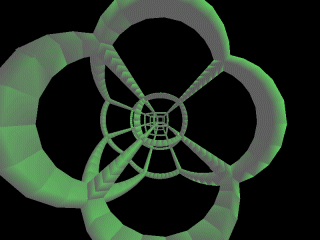Ergh! What a nasty sounding title. But it's not that bad. No really! First, think of an experiment . . . Two spaceships, A and B, are driving towards each other. A spaceman, who is sitting still in space, sees both spaceships going at 1,000,000 m/s (one million metres per second). The pilot in spaceship A wants to know how fast spaceship B is approaching him. In pre-Einstein physics (i.e. before special relativity) he would assume that spaceship B approaching him at 2,000,000 m/s. Spaceship B then slows to a halt. The pilot decides to do an experiment and measure the speed of light. He measures the speed of a ray of light heading towards him. He gets a result of 300,000,000 m/s (that's three-hundred million metres per second). Meanwhile, spaceship A is still going at 1,000,000 m/s. The pilot also decides to measure the speed of a ray of light coming towards him. What result does he get? If you said '2' or '4' then go back and reread this lesson from the beginning. If you said '1' then nearly every physicist in the world would agree with you . . . up until 1905 and Einstein that is. The correct answer is '3' because the speed of light is the same for all observers. This is what special relativity is all about. It doesn't matter if you are traveling at 200,000,000 m/s or standing still, you will always get the same result for the speed of light. A Dutchman named Hendrik Antoon Lorentz realized that this could be explained if objects in motion undergo transformations called the Lorentz Transformations. In these equations x, y, z and t set the coordinates of space and time respectively from an observers point of view. Also, x', y', z' and t' set the coordinates according to the subject. The velocity, v, is in the direction of the x-axis and c is the speed of light. So what does this mean? Well, it means that funny thing happen to the way things look. For example, the first image shows a stationary lattice. The second image shows the same lattice traveling towards us at close to the speed of light! Notice how you can see the back of some of the lattice members despite the fact that they are in front of you! Very strange. v = 0 m/s v -> c Warp simulates the Lorentz Transformations, and it is worth pointing out that if you try moving around a warped object you might find it a bit strange. First of all, as you increase the speed, the object will generally shoot off into the distance. Why? Well, look at the first equation given in this lesson. You see that if we increase the velocity, v, but hold the time, t, constant then x' will diverge from x. Of course in real life it's impossible to increase your speed instantaneously but this is exactly what happens in Warp. Warp holds time still until you tell it otherwise. Remember in the RELATIVITY-II when the teapot went shooting off as you increased the speed? Well you are now in a position to understand what was going on. The speed was increased, the time wasn't, so x' became large and hence the teapot shot off into the distance. Simple. The result of all this waffle is that when you change you speed in Warp, you will also have to change the time. As outlined earlier, you do this using 'space' and 'return'. If you forget to do this, your object will disappear off the edge of the Warp universe, and you'll be terribly upset. Anyway, the object may behave in unpredictable ways because of the way that the twisting at high speeds. If you don't want to get thoroughly confused when moving around objects I recommend reducing the speed before moving. I also find that it is easier to work with the camera fixed on the axes of the Warp universe as outlined in RELATIVITY-I. If you recall, this involved pressing 'r' to toggle the 'camera relative' mode. That said, if you do want to be completely perplexed, please try moving / rotating the teapot around at high speed and see what happens! Moving on, the observant among you will have noticed that the colour of objects in Warp also changes. This is due to Doppler ShiftingLorentz Transforms Explained



Thursday, December 31, 2009
RELATIVITY - IV
Posted by indiakurry at 8:53 PM
Labels: Relativity
Subscribe to:
Post Comments (Atom)
0 comments:
Post a Comment